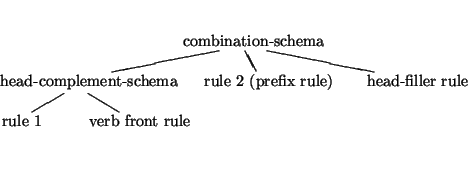- ... construction.1
- See [4] and
[13] for an account in terms of Lexical Functional
grammar, [16] for an account in terms of Tree
Adjoining Grammar, and [10], [28],
[19], and [9] for categorial
accounts.
.
.
.
.
.
.
.
.
.
.
.
.
.
.
.
.
.
.
.
.
.
.
.
.
.
.
.
.
.
.
- ... schemata.2
- In
[27], the analysis of [8]
is used to account for Dutch cross-serial dependencies. The feature
NPCOMP is replaced by LEX, whose distribution is again
governed by the same rule-specific stipulations.
.
.
.
.
.
.
.
.
.
.
.
.
.
.
.
.
.
.
.
.
.
.
.
.
.
.
.
.
.
.
- ... H.3
- We disallow the use
of this rule if both L and R are both instantiated as the empty
list. Thus, there is no place for unary rules in our grammar.
.
.
.
.
.
.
.
.
.
.
.
.
.
.
.
.
.
.
.
.
.
.
.
.
.
.
.
.
.
.
- ... examples:4
- Note that we will
not discuss the Dutch reflexive zich which has some peculiar
properties. The current analysis ([3,15]) of this
reflexive assumes that it needs to be bound by the subject of the
minimal finite domain. Given that verb-clusters at best introduce
non-finite domains the distribution of zich does not
shed any new light on the structure of verb-cluster constructions.
.
.
.
.
.
.
.
.
.
.
.
.
.
.
.
.
.
.
.
.
.
.
.
.
.
.
.
.
.
.
- ....5
- For the moment we
will assume that ``dominates'' is defined in terms of the
ARG-S feature rather than the DTRS feature.
.
.
.
.
.
.
.
.
.
.
.
.
.
.
.
.
.
.
.
.
.
.
.
.
.
.
.
.
.
.
- ...aux2c).6
- Some speakers accept the word order in
(46c) . We come back to this issue at the end of section
6.2.
.
.
.
.
.
.
.
.
.
.
.
.
.
.
.
.
.
.
.
.
.
.
.
.
.
.
.
.
.
.
- ...aux2c).7
- A way out for the binary-branching analysis
would be the ensure somehow that combinations of a ``flipped''
participle and a verbal head are not marked as verb-clusters (see
[1]).
.
.
.
.
.
.
.
.
.
.
.
.
.
.
.
.
.
.
.
.
.
.
.
.
.
.
.
.
.
.
- ... ``incorporation'':8
- For a different analysis of separable prefixes
refer to [2]
.
.
.
.
.
.
.
.
.
.
.
.
.
.
.
.
.
.
.
.
.
.
.
.
.
.
.
.
.
.
- ... apply.9
-
Let us take a moment to summarize the rules and rule schemata used in
this paper:

The combination-schema is defined in (8) and (9).
The head-complement-schema is defined in (12). Rule 1 is
an instantiation of that schema, with the ordering constraint
(15) added.
.
.
.
.
.
.
.
.
.
.
.
.
.
.
.
.
.
.
.
.
.
.
.
.
.
.
.
.
.
.
